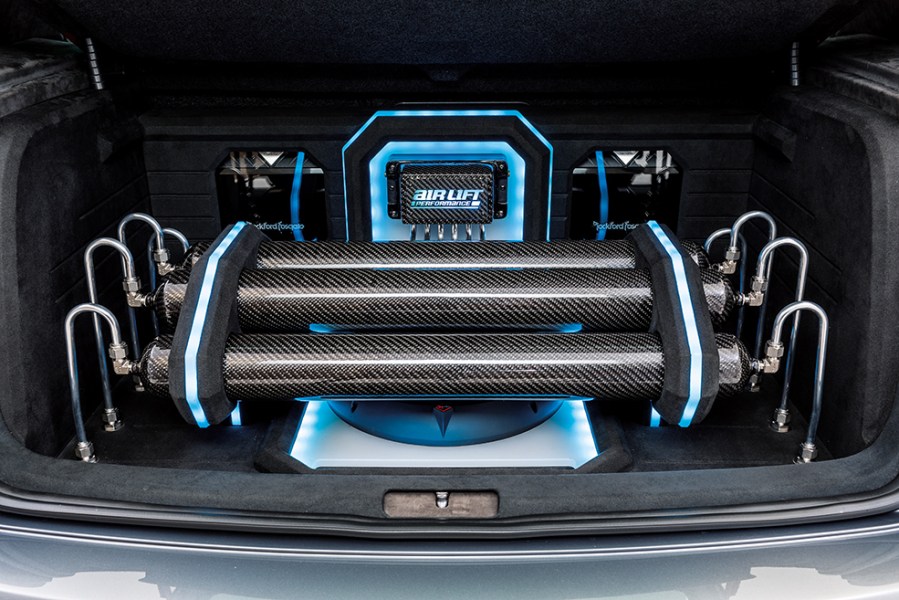So here it is, our air ride suspension guide. Learn everything you need to know about changing your car’s ride height with air bags.
It’s true to say that nothing has changed the show scene over the past decade quite as much as the availability of amazing air ride kits. But, while there are plenty of modern innovations, that’s not to say that the idea of air suspension is a new thing. Air ride systems have been around for about as long as cars themselves. Initially conceived to allow carrying heavy or uneven loads in relative comfort, there are examples as far back as the early 1900s. Various aftermarket kits have been on sale since the 1920s, and it became extremely popular with American bootleggers and whiskey trippers in the ‘30s and ‘40s for maintaining stock ride height with a boot full of moonshine. Looking for the best suspension? Be sure to check out our guide to the best car suspension brands in 2023.
Nowadays, of course, you’ll find OEM applications on everything from buses and HGVs to expensive SUVs and saloons. In short, air ride is far more common than you might think; it’s not some sort of underground dark art. To be honest, it’s not particularly special either… until it comes to the world of modified car culture, of course.
But the question still remains, why should you look at air ride suspension as an option for your weapon of choice? Well, if you’ll excuse the pun, here’s the FC lowdown.
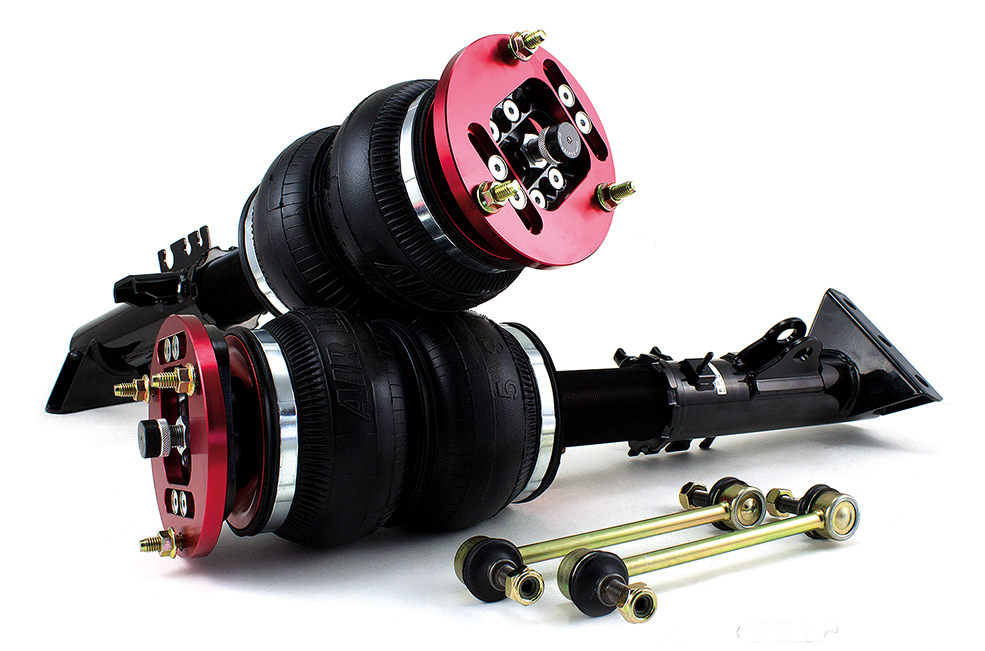
What is air ride suspension?
Air suspension is the only truly practical way of drastically changing your ride height on the go. Although many forum ‘experts’ will scoff, it comes with more benefits than simply being able to dump your car into the weeds. Yes, of course it makes your car look cool, but that doesn’t mean it has to come with a huge compromise on performance. Old school hydraulic systems tend to offer a whole load of compromises, but air? Well, that’s a different animal. The best quality modern vehicle-specific kits are built with performance in mind. In most cases, it will not only offer better handling than standard, but very often they’ll boast greater tuneability than coilover or spring and damper set-ups too.
The truth is that, just like performance springs, modern airbags are progressive. The more they compress the stiffer they get. This dynamic spring rate offers plenty of performance potential, especially combined with an optimal damper set-up. In fact, air ride was popular in drag racing and NASCAR as far back as the 1950s. There’s also plenty of race cars and drifters running air suspension right now, more than you may think.
When it comes to tuneability, with air suspension the ride can be firm and tight, soft and comfortable or anywhere in between. You can increase the pressure to firm up the ride for the circuit and then drive home in the lap of luxury, all at the push of a button. Then again you could just want to run your car super low but with the benefit of actually being able to get on your drive – a really novel concept we’re sure!
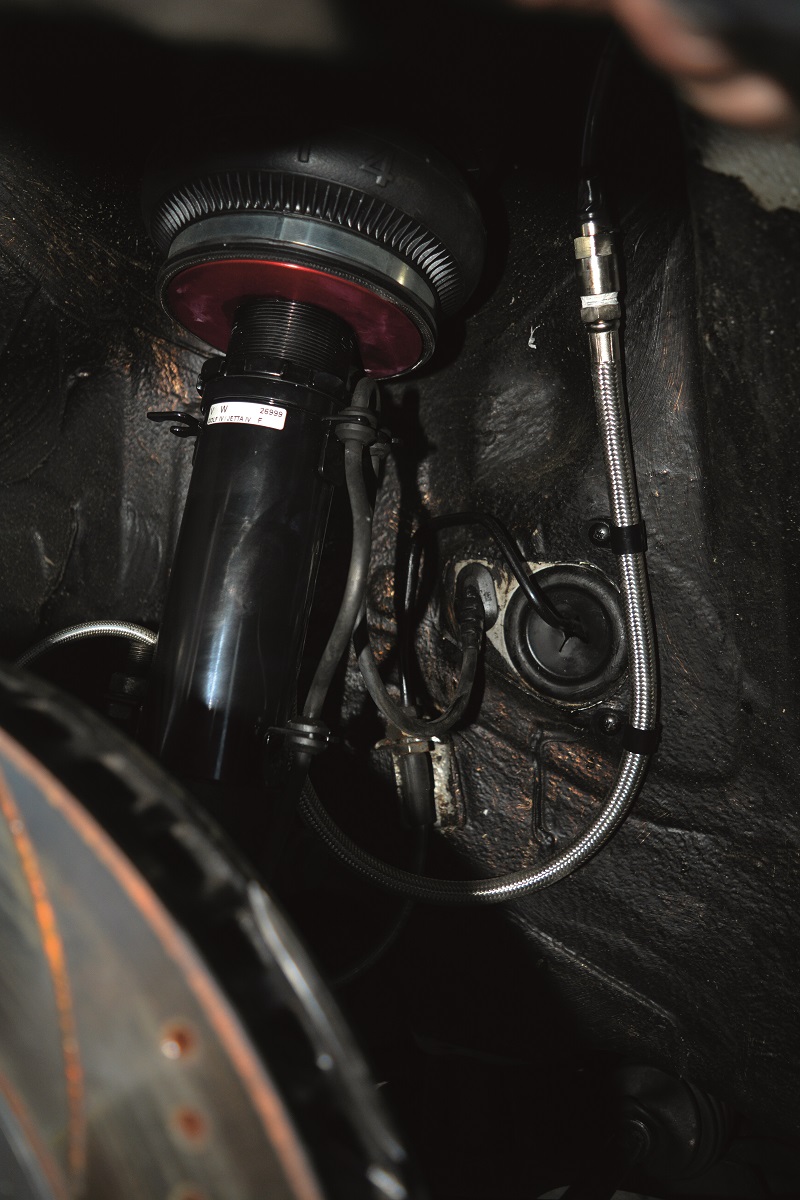
How does air ride suspension work?
There may be a few different configurations out there but the principle of how air ride works is always the same. Unlike ‘closed’ system hydraulic suspension, which uses a specific amount of fluid pumped (at extremely high pressure) from a sealed reservoir to rams on each corner, air suspension employs an ‘open’ system which expels and replaces air.
In a street car system this cycle all centers around an air tank. Valves or solenoids transfer air to each airbag, lifting the vehicle as the pressure increases. The same air is expelled to the atmosphere when the time comes for lowering.
The idea is that a compressor will keep the tank topped up at all times, and the tank acts as a reservoir for the bags. Obviously, a bigger tank means more air in reserve for numerous rounds of lifting and lowering, while a larger compressor (or multiple compressors) will fill the tank to the optimum pressure faster.
Theoretically it is possible to run a system directly from a compressor, although it would take almost forever to ramp up enough pressure to raise the car. Some race cars and trucks have also been known to employ a type of closed system by doing away with everything bar the bags and using an externally mounted valve to fill them. On a road car, though, this isn’t exactly practical – after all, in-car adjustability is the whole point.
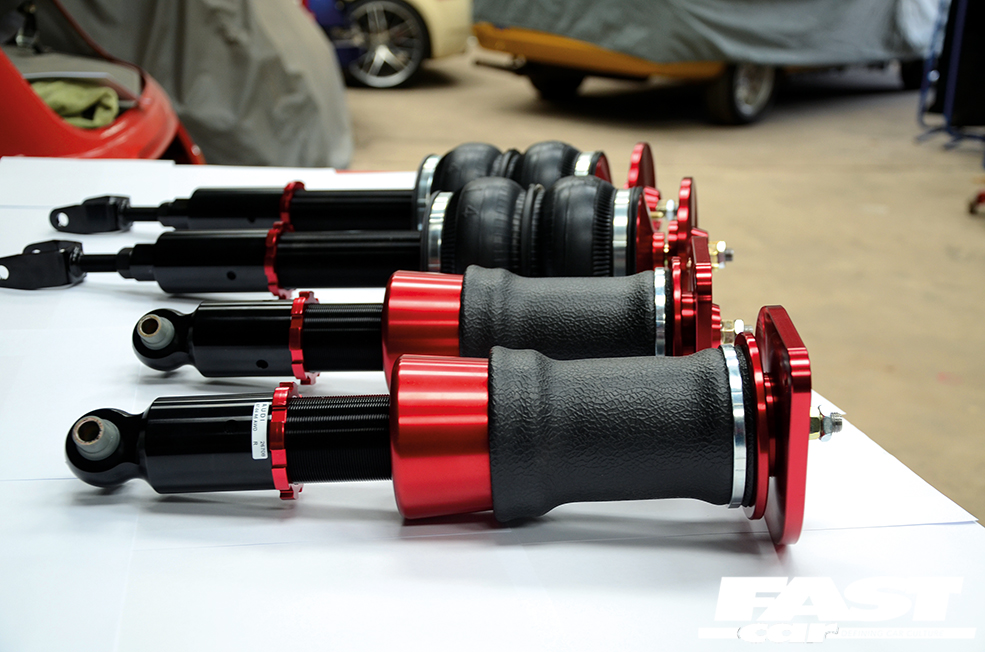
Why would you want to run air ride suspension?
Air suspension has many uses. As previously mentioned, hauling and transporting is one of the larger uses, but it’s also hugely popular in the performance and styling scenes for allowing extremely low ride-height settings while still giving the ability to lift on demand and overcome even the most troublesome highways or on-road obstacles.
Are there any downsides to air suspension?
Everything has pros and cons, but the downside of air is a very short list.
- Most air ride kits tend to be better suited for road and show cars over track cars, which favor height adjustment and ride quality over outright handling performance, but air suspension systems can be very capable performers when spec’d correctly.
- The odds of something failing and going wrong (bag popped, line blown, etc.) is very rare, unless you install it incorrectly.
- Go with quality kit from a reputable company, matched with a quality install, and you will be perfectly happy.
What other mods should you consider when fitting air suspension?
When it comes to lowering your car as low as possible for the perfect stance, nothing goes with air suspension better than the proper set of rims. The right wheel and tire combo is the perfect complement to a lowered vehicle of any kind. Air Lift recommends having your desired wheel and tire package already in mind when installing your air suspension to ensure everything will clear and work perfectly when it’s all installed.
What components are needed for air ride suspension?
Airbags
An airbag, or to give it its proper name, an air spring, is just that – a simple pneumatic spring. Its job is to replace the standard coil, whether that’s in a coilover-damper configuration or a separate spring and damper set-up. Essentially this process is simply swapping out a coil for a spring that adjusts with air pressure.
There’s two common types of bag design – double convoluted bags and sleeves. The former, also known as bellows bags and donuts, are the most common these days and nearly always found used on the front suspension. These have a shorter stroke than sleeves but a superior load capacity and a more progressive spring rate. Tapered or rolling sleeve designs may turn up on the rear where clearance is an issue or if a higher lift is required. These are smaller in diameter than bellows bags and generally have a smaller load capacity.
Nowadays, all manufacturers design bags specifically for liner travel and this means that they’ll expand and contract upwards and downwards rather than simply blow up like a balloon. They’re also suitably durable and contrary to popular belief they’re not at all easy to burst and will hold well over 100psi. On a road car that’s more than you’ll ever need.
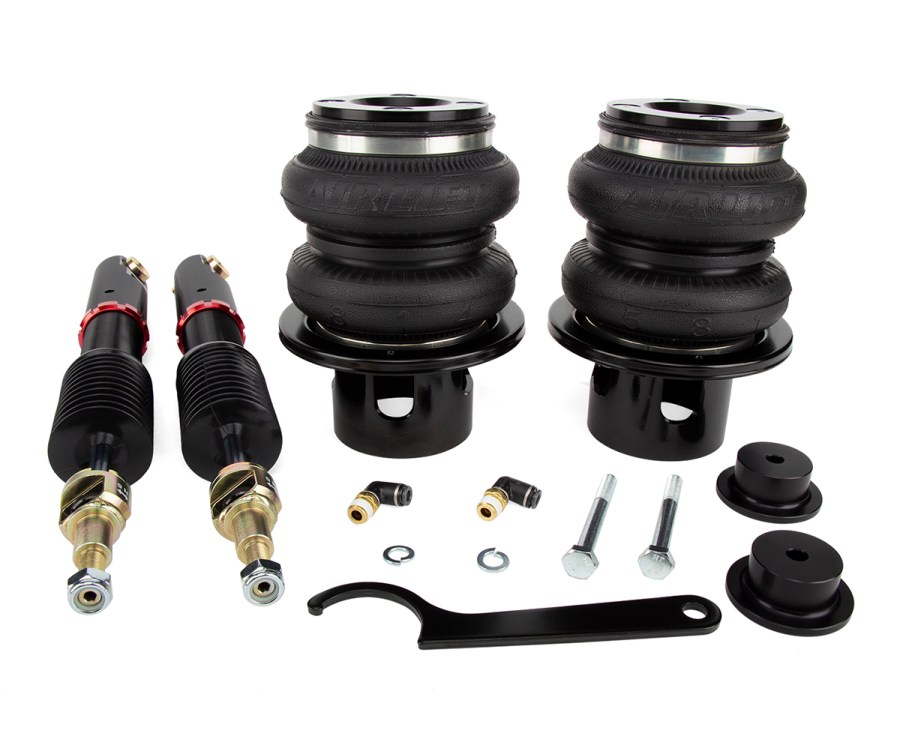
Shocks
The big advantage of air ride systems over hydraulics is that you can improve the car’s standard quality of handling or, at the very least, retain it. This has a lot to do with air being easily compressible to absorb bumps (unlike hydraulic fluid) but has even more to do with the system being able to retain a proper damping set-up.
All modern vehicle-specific air ride kits come with matched shock absorbers; often supplied by well-known aftermarket manufacturers in the form of stripped-down coilover units. Some even have camber-adjustable top mounts and, as you’d expect, come with multi-stage adjustable damping and all the trimmings.
If it’s an older car you’re building, then there may be the rare occasion where a specific kit isn’t available. In most cases you can adapt universal items for application relatively easily. Some universal kits will come with a range of dampers already installed, others will have bags with a simple provision (like a hole in the middle) to retain a shock absorber. The point is, with air ride you’ll always keep some sort of damper, and that’s obviously pretty vital for handling.
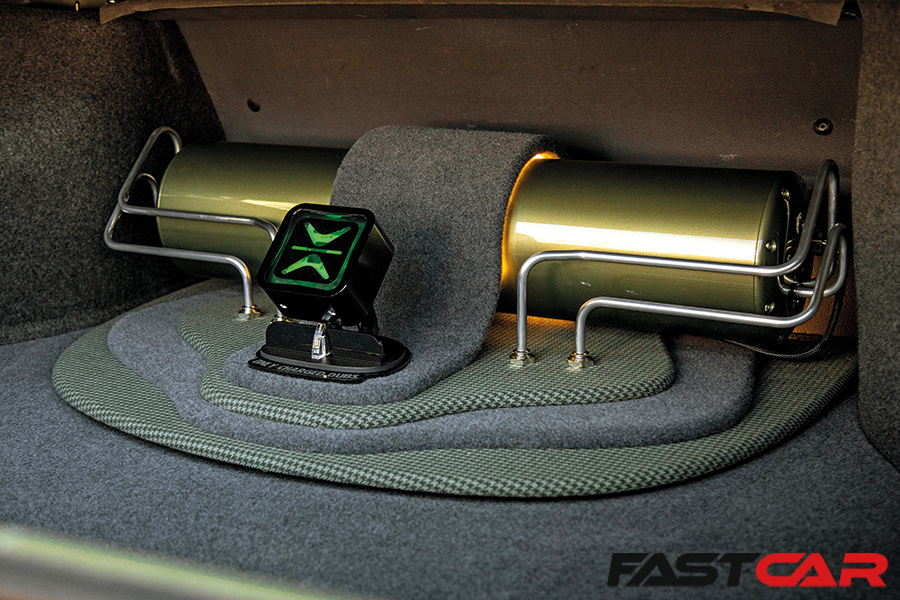
Tanks
The air tank is the business end of the operation. It’s the air supply to the bag on each corner. It’ll be no more complicated than the air tank on your average workshop compressor, though, albeit with a few more fittings. All you really need to know is which one to choose for your particular application.
In the old days, tanks were mostly made from steel and hidden away from view but now we tend to regard them as more of a showpiece. For this reason there’s also plenty of alloy items available in a number of bare, polished and painted finishes. Some are skinned in carbon fiber or have all their welding polished out for a seamless look. Of course, it doesn’t hurt performance when all these are relatively lightweight too.
Generally speaking, air tanks are universal items and available in a range of sizes; this offers a trade-off between boot space and a system suited to repeated use. The more air in the tank, the more you can mess about with that ride height without waiting for a top-up. Some companies also offer tanks that are specifically designed to save space by fitting in a spare wheel well.
It’s worth remembering that every kit will come with a tank, some will offer a choice, but custom tanks are also getting more popular than ever. We’ve seen everything from adapted nitrous bottles, scuba tanks, fire extinguishers and even beer kegs. Anything that can safely hold air at high pressure could be a viable option.
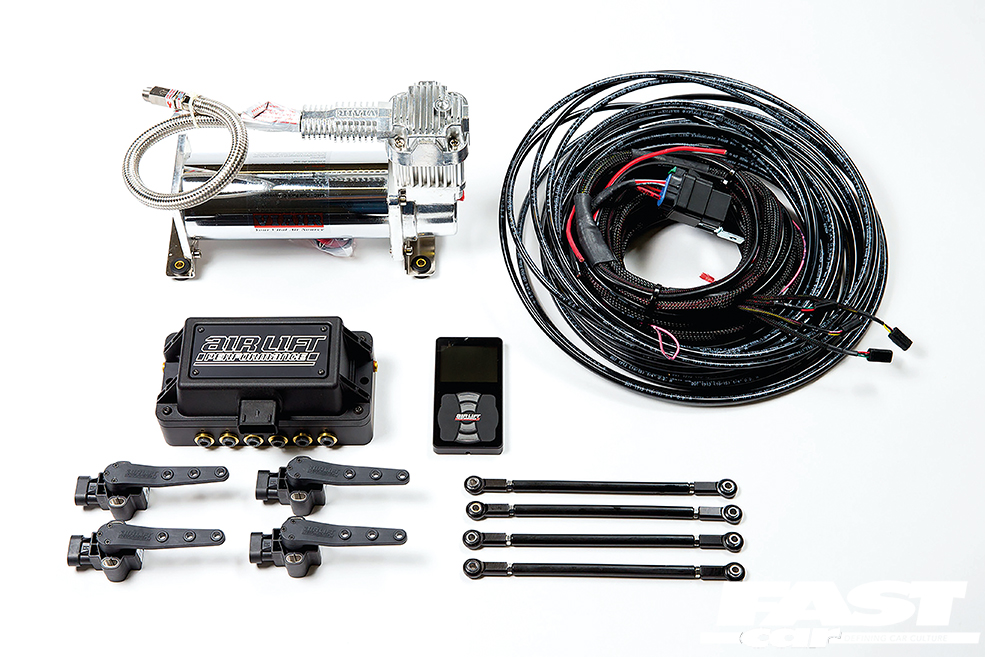
Compressor
The simple job of keeping enough air in the tank is one that falls to a 12-volt compressor. Various sizes are available, and many people use more than one for rapid tank filling. After all, the faster the air is replaced, the more you can use your suspension. Compressors are inherently noisy too; another argument for using multiple units and keeping them running for an absolute minimum of time. At the very least you’ll want to take this into consideration when you’re looking for a place to mount yours.
Controlling how much pressure the compressor pumps into the tank is also crucial. More basic systems use a pressure switch between the compressor and tank to cut power when the optimum psi is reached. Systems with digital management will often have the pressure switch incorporated into the manifold and a tank pressure display on the controller. In both cases, this will make refilling the tank to the desired pressure automatic.
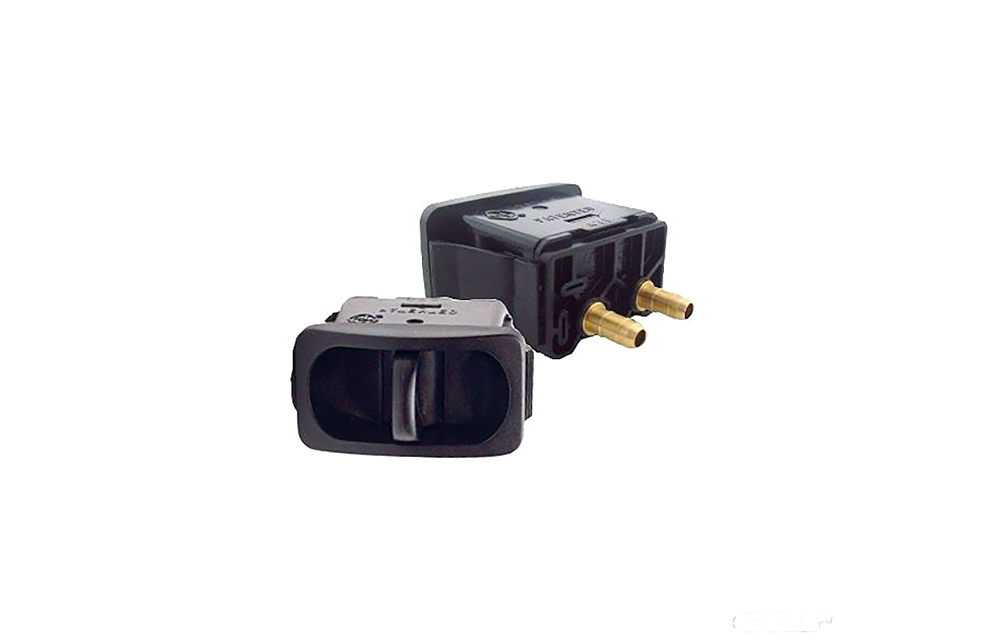
Valves
The valves have the purpose of controlling the airflow from the tank to the bags. In many cases, they also have the job of expelling the air upon lowering the car too.
The simplest manual systems come with paddle valves, which look like switches and mount within easy reach of the driver. On the back they’ll have a feed from the tank, an output for the relevant airbag and an exhaust port to dump the air. It’s a simple, reliable and cost effective set-up but one that does come with a few compromises.
Because the airlines need to go through the valves it requires running them into the cabin during instillation. If your tank is in the boot, you’ll have a feed from the tank to the dash and then another back out to the rear bags. Due to the small diameter of the paddles, raising the vehicle can be a little slow too.
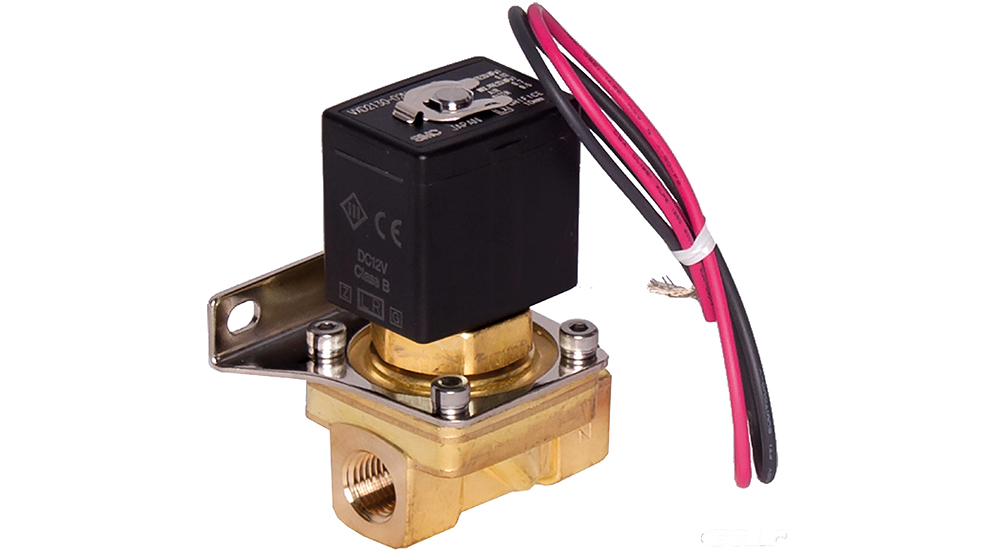
Solenoids
These are simply electrically operated valves and designed to eliminate the need for paddle valves in the cabin. They’re a little more expensive, but enable the use of electrical switches, or switch boxes, and don’t require any airlines being routed inside the passenger compartment. In some configurations these are individually mounted directly to the air tank. This is why you see some tanks with four threaded fittings in the front. In other kits solenoids are supplied mounted-together in a manifold (or solenoid block) with an exhaust port and single tank feed. These make installation a far easier job.
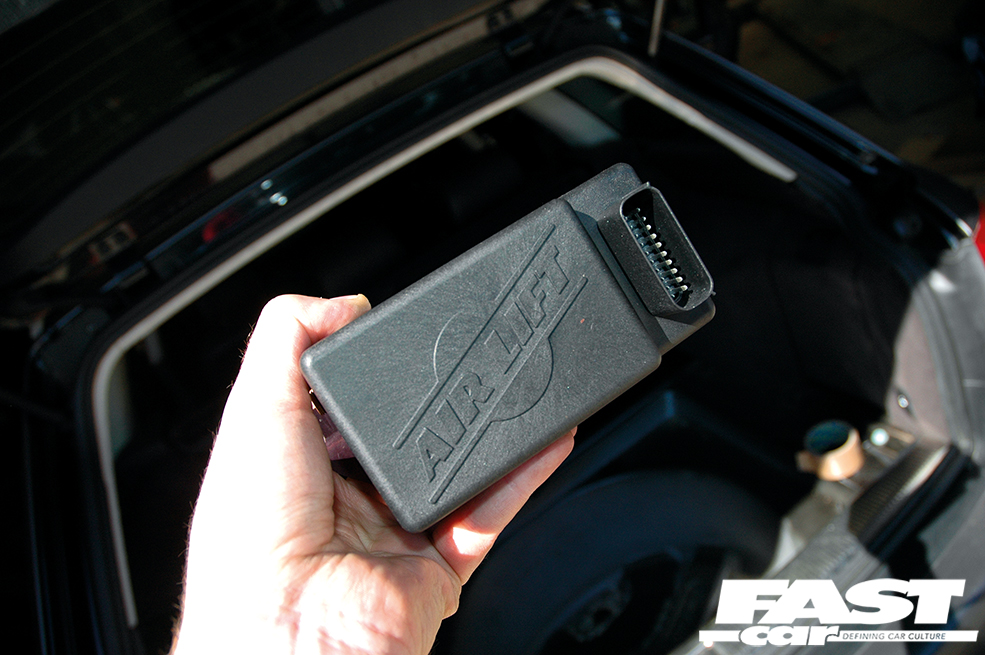
Digital Manifolds and Management
To be honest, nowadays you’ll likely be wanting one of these. Designed not only to make instillation as easy as possible but to also ensure day-to-day use is much more user-focused. Digital management is fast becoming the norm, especially for daily-driven modified projects.
Again, a digital management system will incorporate a manifold containing a collection of solenoids to control the airflow to each corner. But they’ll also work with a simple plug ‘n’ play wiring loom to take over management of the compressor functions and the power to the whole system. Many also include a handy feed for a second compressor. Although they’re all essentially universal systems, very often there’s only two or three wires that you need to hook up to the actual car. In other words, for DIY installations, they make life much easier. Although that will inevitably come at a premium price.
Most professional installers will admit that home mechanics who can fit a set of coilovers and wire in an amplifier will have little trouble fitting a digital air ride kit.
Each system works around an electronic control module designed to add a whole host of extra features. These digital set-ups are on the cutting edge of functionality and allow trick touches. These include things like automatic levelling and adjustment, pressure monitoring, physical height monitoring, lift-on-start and emergency auto top-up.
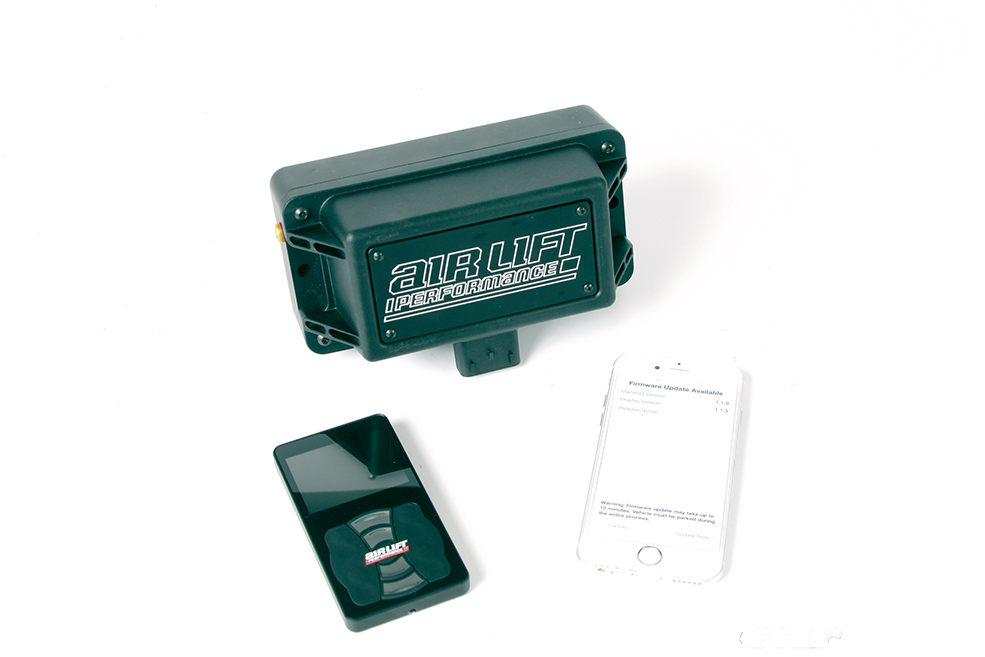
Digital Controllers
Designed to work in conjunction with the management system, the controller negates the need to mount paddle valves or switches in your dash.
Some of the high-end management systems – like 3H and 3P kits from Air Lift Performance – also employ Bluetooth. This means you can use your smartphone or tablet as a digital controller (via an app).
Perhaps the most important feature on digital controllers, and why they’re so popular, is the ability to program a number of ride height pre-sets. This means you can reach the desired level either automatically on start up or at the touch of a button; something that you definitely can’t achieve with a paddle or simple solenoid-based system.
Gauges
Pressure gauges are important in any budget paddle system to keep a check on what’s going on at each corner. These offer the only way of knowing the ride height without physically getting out and having a look. Assuming, of course, you know the optimum pressure for each bag. Most air ride gauges offer a dual readout so it’s rare that you’ll need a separate item for each.
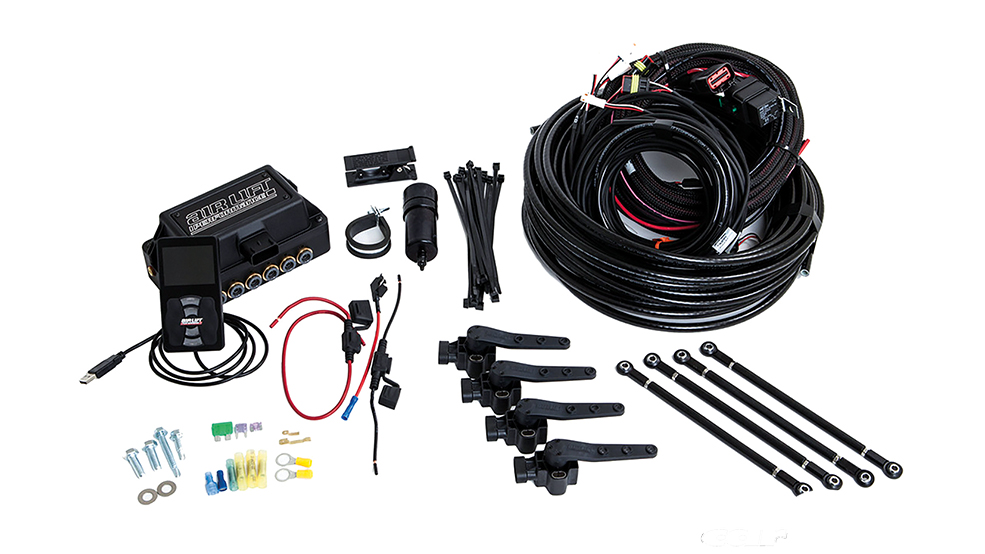
Height Sensors
The vast majority of air ride systems, including those with digital management, are based purely on monitoring and maintaining a pre-set pressure in each airbag. There are a few, however, that rely on electronic height sensors mounted to each corner of the chassis. These automatically maintain a constant ride height no matter the load, distribution or amount of passengers. This is a well-established idea that works well in changing vehicle conditions, but the best next-generation systems can monitor both ride height and air pressure. The latest 3H Management kits from Air Lift Performance are designed for exactly that. They use a complicated algorithm incorporating height and pressure information to keep the level constant at all times.
Airline and Fittings
The airlines have the job of connecting all the other components together. Most air ride kits include a good few meters made from commercial, DOT-approved plastic. Now, although no one likes to hear the word ‘plastic’ when it comes to holding their pride and joy up off the tarmac, it’s actually far safer than it sounds. After all, they’ve been using exactly the same stuff on HGVs for years, usually on the brakes!
Commonly available in 1/4-inch and 3/8-inch diameters, the thing to consider is that bigger lines equal faster inflation of the bags. This, however, may come at the cost of overshooting your target pressure more easily. Whatever size you use, all modern airlines come with simple instillation in mind. Kits will always include premium-quality, push-fit hardware making it a simple case of cutting the line to the correct length, and pushing each end into the fittings. That’s about it.
Hard Line Installs
For maximum flash at the local show ‘n’ shine, many prefer a ‘hard line’ install. For the most part, it’s exactly what it says on the tin. What they don’t tend to shout about so loudly is that replacing some or all of your plastic lines with copper or stainless steel piping is easier than you might think. In fact, it’s not unlike making up a brake or clutch line. Provided they are the same diameter, they’ll even push into the same fittings. Simple.
Arguably hard airlines offer no real performance benefits because there’s no noticeable flex in the plastic airlines anyway. They’ll almost certainly require more fittings (with an increased risk of leaks around the joints) too, but there’s no denying they can make any boot install look amazing.
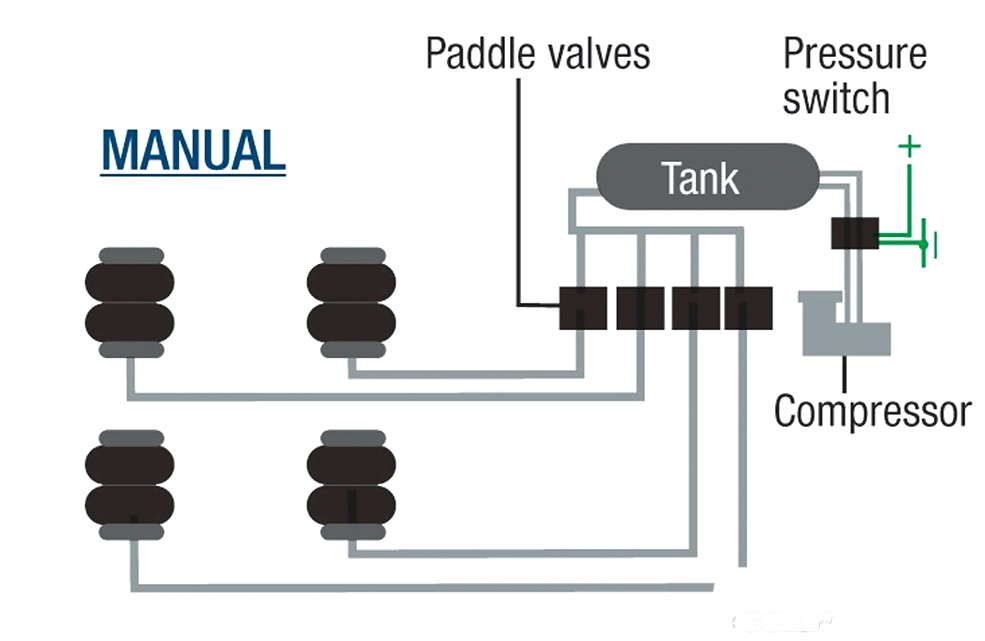
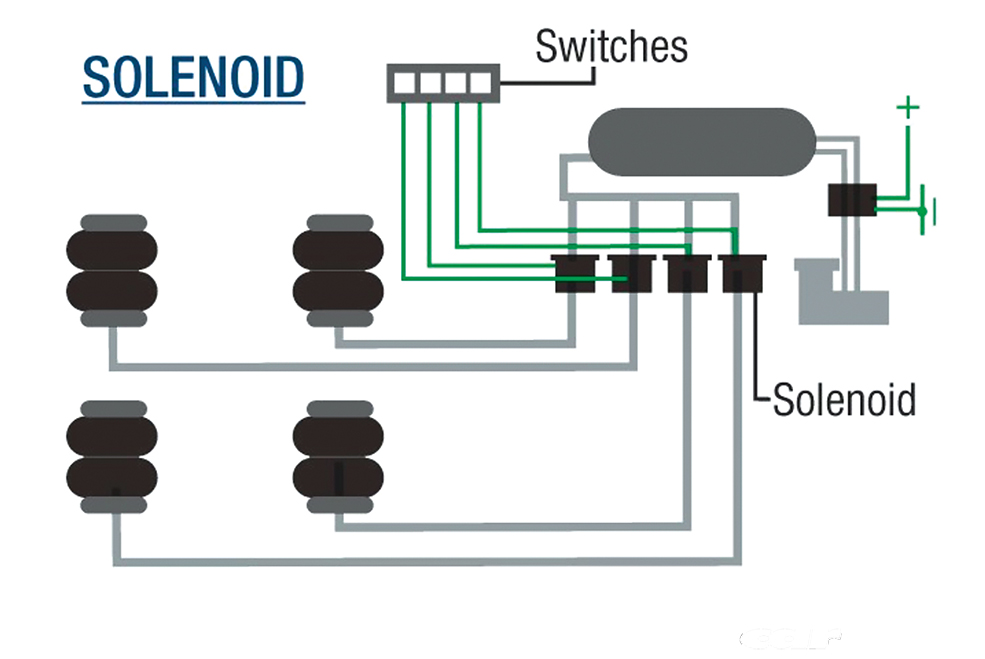
Air ride suspension configurations
2-Way and 4-Way systems
The first thing to consider is exactly what type of kit you’d like to go for. Nowadays 4-Way systems are by far the most popular. As you’ve probably guessed, these allow for precise adjustment of each corner individually.
2-Way systems (in which the bags on each axle hook together) were popular in the past, particularly in the US. This is because of the ease of fitment and the fact you only need two valves or solenoids. One for the front and one for the rear. The downside is that we actually have corners and roundabouts here in Europe. A 2-way system can magnify body roll in any bend because the loaded airbag on the inside will always try to transfer the air to its unloaded partner. To put it bluntly, 2-Way systems aren’t always the most practical in performance cars and everyday drivers… although if you’re building a quarter-mile-munching hot rod they could still be useful.
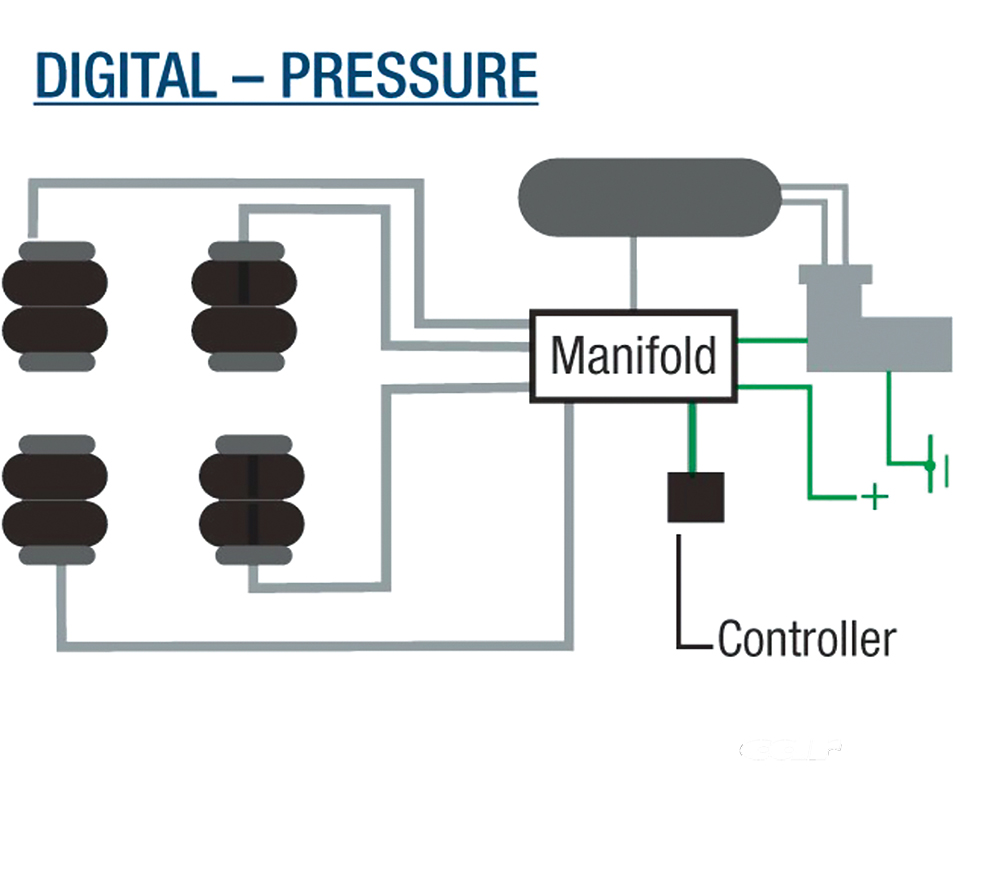
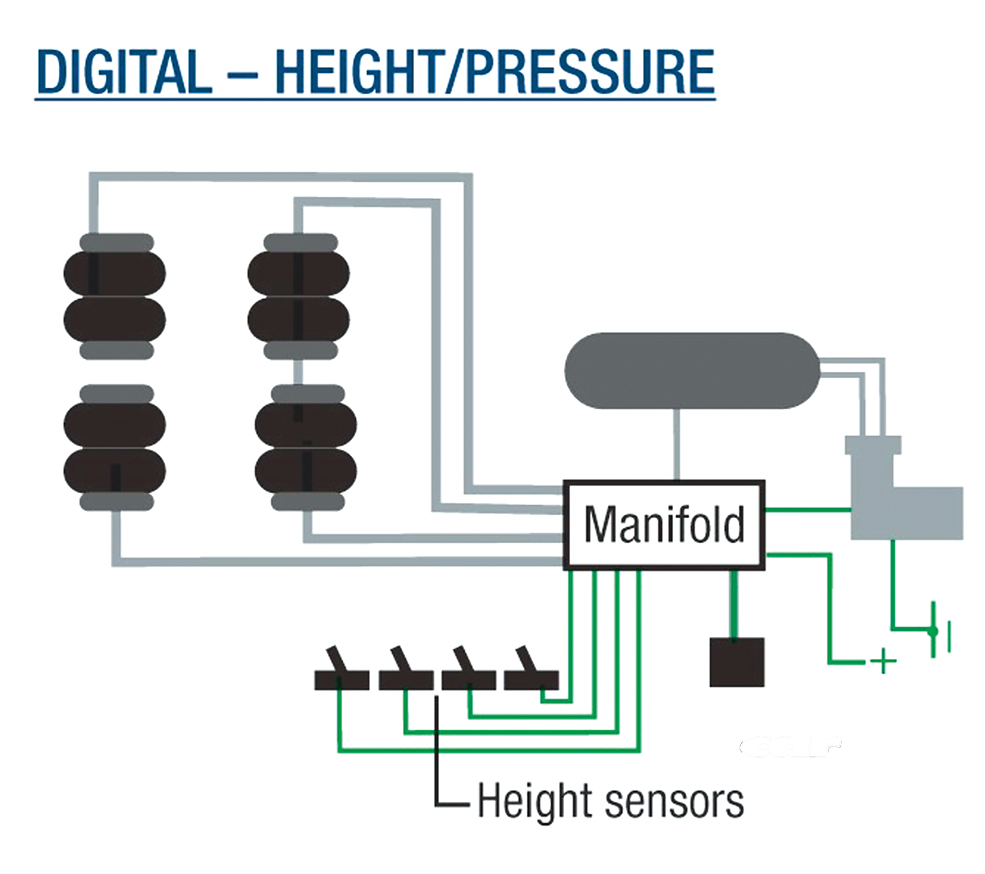
Basic 4-Way set-ups
Nowadays most cars go for a 4-way system. We’ve also talked about the fact that some systems incorporate digital management and others use valves or solenoids, but what’s important is that each configuration takes a different approach to installation.
It’s also good to remember that you can adapt each of these set-ups to your particular application with different size airlines and tanks, or the use of multiple tanks and compressors. In their very purest forms, though, there’s four basic ‘single-tank-single-compressor’ set-ups: manual (paddle valve), solenoid-controlled, digital-pressure and pressure/ride height-sensing digital management systems. Here’s what they look like…
Air ride suspension maintenance
Air suspension systems don’t require much more maintenance than a set of coilovers – just a quick check over once in a while to make sure nothing is rubbing, worn or broken. Despite what you might hear, leaks and split bags are extremely rare. A properly-installed kit should last a lifetime as long as you remember one little rule – moisture in the system is the enemy. Basically speaking, fluid getting into a digital manifold is bad news for your wallet. If that fluid freezes in the airlines, the worst case scenario is that it’ll expand and split the plastic pipes.
The problem is that all compressors create moisture and it will often accumulate in the tank before being pushed around the whole system. Luckily all modern tanks should utilize a separate valve at the bottom, which should be periodically drained. It’s best to do this after ‘airing out’ your car and, in most cases, this will shed any fluid lurking in the system. Some kits also come with various water traps in between the compressor and tank or the tank and manifold.

